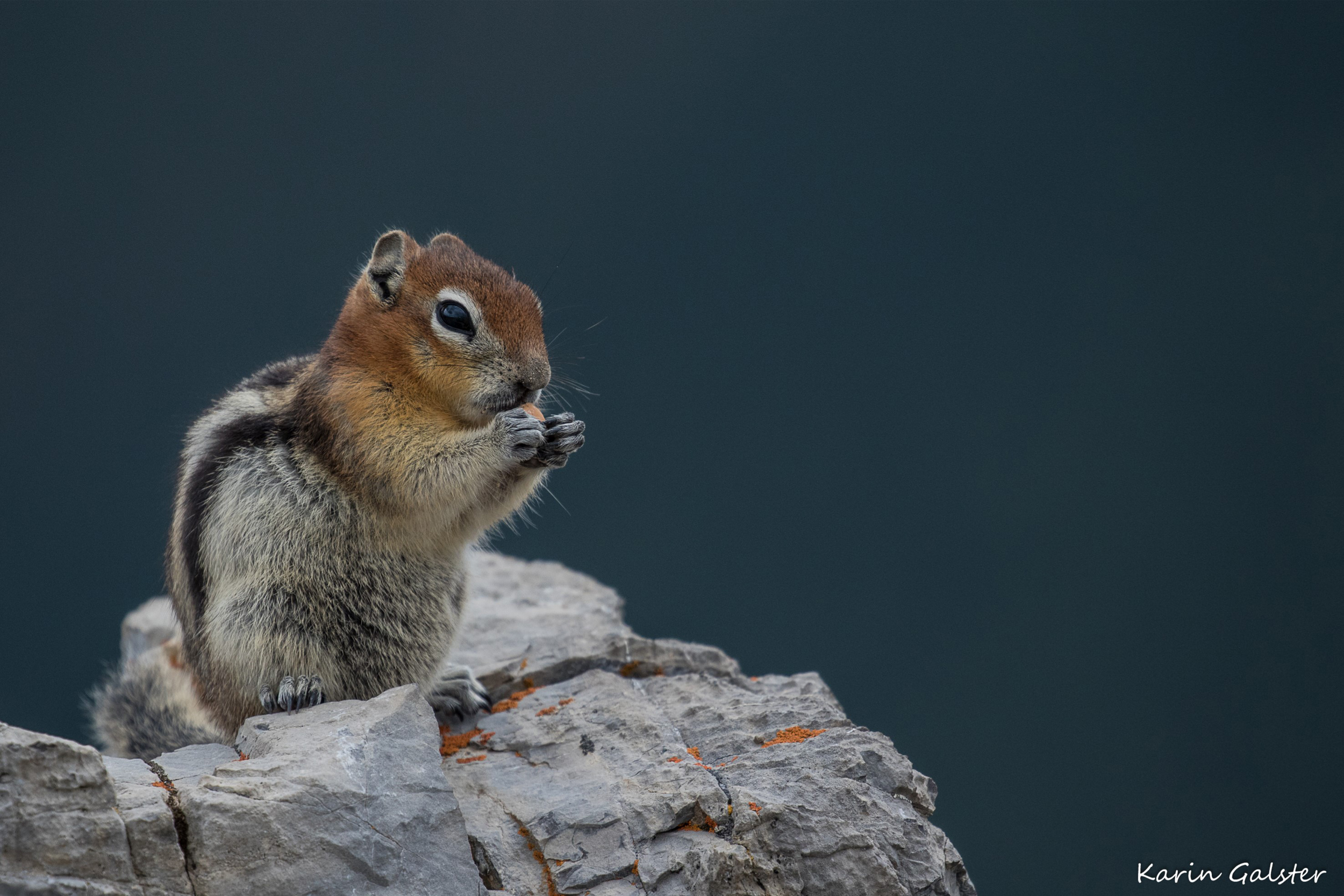Squirrels are a very diverse group of small to medium-size rodents indigenous to every continent except Australia and Antarctica. There are many different types: tree squirrels, ground squirrels, chipmunks, marmots, flying squirrels and prairie dogs. All of them are members of the squirrel family (Sciuridae). During our stay in Canada we have been able to discover not only some new (for us) species of tree squirrels, cousins of our Eurasian red squirrel, but also a number of ground squirrels and one chipmunk species.
The American red squirrel (Tamiasciurus hudsonicus) can be found in most of Canada and some parts of the US. It typically favours habitats with large conifer forests, as it has a serious penchant for various conifer seeds. However depending on availability its diet is occasionally adapted to include spruce buds, mushrooms, leaves and flowers, berries and even bird eggs. With its reddish fur and whitish underbelly it looks very much like a smaller version of the Eurasian red squirrel.
The Eastern grey squirrel (Sciurus carolinensis) is another species of tree squirrel widely distributed across North America. Native to the eastern part of North America, the species has been introduced to other areas of the continent, including the parks of Vancouver, the only place where we came across them. Grey squirrels are much bigger than their red cousin and have predominantely grey or sometimes greyish brown fur. The melanistic, almost black form, which we saw, seems to be very common in certain populations or particular areas. In its historical range the grey squirrel plays a vital part in the natural regeneration of the forests, however in areas where it has been introduced, in particular in Europe (but also other parts of North America) its thriving populations are a serious threat to local wildlife. Being larger than the indigenous red squirrel it can build up much bigger fat reserves to survive winter conditions. Grey squirrels are also healthy carriers of the squirrelpox virus against which our local red squirrel has no immunity. In certain regions, in particular in the UK, red squirrels have already disappeared under the pressure of the rapidly growing grey squirrel populations. Once considered a fashionable addition to Victorian estates it has now been classed as an invasive species and pest in several countries and programms have been put in place to eradicate grey squirrels in order to save the indigenous red squirrel.
The yellow-bellied marmot (Marmota flaviventris) is a medium-sized ground squirrel that lives in the mountainous regions of southwestern Canada including the alpine meadows of the Rocky Mountains. Roughly the size of a cat it was aptly named for the yellow fur on their belly. Its head and nose are darker, but they have a white patch on the snout just below the eyes. Like all marmots, as soon as it detects a potential danger it whistles to warn other marmots in the area. The only place we saw one individual was in the rocks above the trail leading to the Bow Falls in Banff National Park.
The golden-mantled ground squirrel (Callospermophilus lateralis) is native to western North America and can be found in British Columbia and Alberta through to the US states of California, Arizona and New Mexico. We had many occasions in both Jasper and Banff National Park to meet this rather pretty and curious little creature. It prefers forests and their edges and in particular rocky areas where it can easily hide from potential predators. Like marmots, it hibernates over the winter. The golden-mantled ground squirrel is omnivorous and its diet includes vegetation, berries and seeds, acorns and mushrooms, but also insects, lizards, birds eggs and if given the opportunity food left over or offered by humans. They are pretty fearless and bold and don’t hesitate to get up close in the hope of scrounging a few tasty morcels from one’s hand. But they gave up on us quite quickly when they realised we weren’t playing ball….
The Columbian ground squirrel commonly occurs in some regions of western North America. Much bigger and stockier (or should I simply say fatter?) than the golden-mantled ground squirrel it looks more like a marmot than a true squirrel. It can be found in alpine and subalpine regions, but also in meadows and grasslands and we even came across them on campground lawns where they had dug an extensive labyrinth of tunnels for their burrow. Unlike the golden-mantled ground squirrel it is almost exclusively vegetarian and mainly feeds on fresh succulent vegetation. It spends around 250 days of the year in hibernation!
The least chipmunk (Neotamias minimus) is the smallest of the chipmunk species in North America, the average adult weighing no more than 25 to 66g! Its range includes the southern and western parts of Canada as well as the western part of the US. Its diet includes seeds, nuts, berries, fruits and insects. Least chipmunks don’t hibernate and don’t put on fat reserves, but they spend the winter inside their burrows in a state of decreased physiological activity and only wake up occasionally to feed on food supplies stashed away in their burrow.



































































